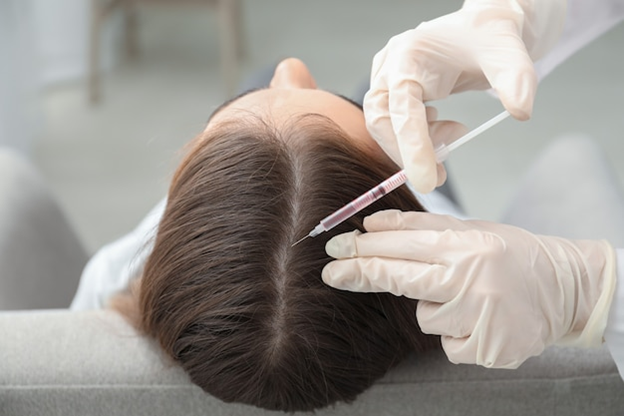Hair loss can greatly upset anyone experiencing it, affecting men’s and women’s confidence and self-image everywhere. Using PRP for hair growth has emerged as a hopeful solution. This method provides those experiencing hair loss with a minimally invasive way to hopefully restore their hair. Many people don’t fully understand what PRP therapy involves. This guide aims to demystify it, making PRP hair treatment easily understandable for all.
Unpacking PRP: Nature’s Own Hair Growth Solution
PRP hair treatment uses your own blood to help foster hair growth, making it a natural remedy. A quick blood draw from the arm collects the patient’s blood. This sample then undergoes centrifugal spinning to separate the platelet-rich plasma. This plasma contains growth factors essential for healing and regeneration. The autologous nature of PRP hair treatment minimizes the risk of allergic reactions or rejection. Safety and effectiveness hinge on this “nature’s solution” derived from the body’s powerful components.
Science of Hair Regeneration: PRP’s Inner Workings
Platelets play a vital role in our body’s recovery processes, including hair growth. This PRP hair treatment taps into the power of growth factors like PDGF, TGF-β, and IGF-1. These factors trigger biological processes that awaken dormant hair follicles. Increased activities in these areas enhance the scalp’s condition, leading to new growth. The science behind this process rests on signaling, where these factors prompt follicles to spring back to life and resume growing.
PRP Infusion into the Scalp: A Closer Look
The PRP process involves injecting this plasma into the scalp to stimulate hair regrowth. The treatment starts with cleansing the scalp, followed by skilled injections at targeted sites. On a cellular level, the growth factors released during the PRP hair treatment trigger new blood vessel formation, known as angiogenesis.
- These growth factors promote follicle activity, setting a stage for hair growth.
- Cell activity gets enhanced, leading to healthier, fuller hair.
- Over time, this procedure promotes thicker and lusher hair development.
The biological synergy between these factors facilitates visible changes in hair volume and density.
Ideal Candidates for PRP Hair Treatment
PRP for hair growth best suits those with early-stage hair loss or thinning areas. – It’s ideal for those looking for non-surgical methods. – People with diseases like alopecia might consider other options. – Consulting with a specialist ensures setting realistic expectations.
While PRP treatment offers benefits, it’s not magical. Knowing whether it’s suited to one’s specific condition is crucial beforehand.
Demystifying the PRP Treatment Journey: From Consultation to Aftercare
Embarking on a PRP hair treatment journey starts with a consultation. A qualified professional evaluates your condition, discussing potential benefits and setting expectations. PRP for hair growth typically involves a simple blood draw, followed by repeated sessions based on individual needs. Discomfort is generally minimal.
- Session Frequency: Usually involves initial monthly treatments over 3-4 months, followed by maintenance sessions every 3-6 months.
- Aftercare: Post-procedure, avoid washing the hair for a set period and follow prescribed routines.
- Adherence to Guidelines: Following professional guidelines ensures maximal benefit and minimal side effects.
Results and Benefits: What to Anticipate from PRP
Expectations from PRP hair treatment often include:
- Reduced Hair Shedding: The initial few weeks may show decreased hair loss.
- Increased Density: Noticeable changes in hair volume can typically occur within several months.
- Long-lasting Effects: Continued treatments foster ongoing benefits for hair health.
While PRP for hair growth shows promise, keeping a realistic view of its capabilities is vital. Continued technological advancements may broaden its possibilities, but current research suggests moderation in expectations.
Comparative Insights: PRP vs. Other Hair Restoration Options
PRP hair treatment stacks against various restoration methods like topical applications or laser therapies by offering:
- Minimal Invention: Compared to surgical hair transplants.
- Complementary Nature: Excellent pairing with other ongoing treatments.
PRP shines through its natural alignment with the body’s own mechanisms, offering a unique role in comprehensive hair restoration plans.
Concluding Thoughts on PRP for Hair Growth
PRP for hair growth taps into your body’s healing powers, promoting healthier hair naturally. While it may not be a fit for everyone, consulting a healthcare provider for tailored advice is wise. This exciting method of using PRP holds great potential in the journey toward fuller, healthier hair, with ongoing advancements promising to expand its effectiveness. Anyone interested should consider professional guidance to understand its suitability fully. This exciting approach offers promise, but staying informed ensures the best outcomes.
Discover if PRP is right for you—Book your consultation at Sparderm Advanced Dermatology and Aesthetic Clinic today!

